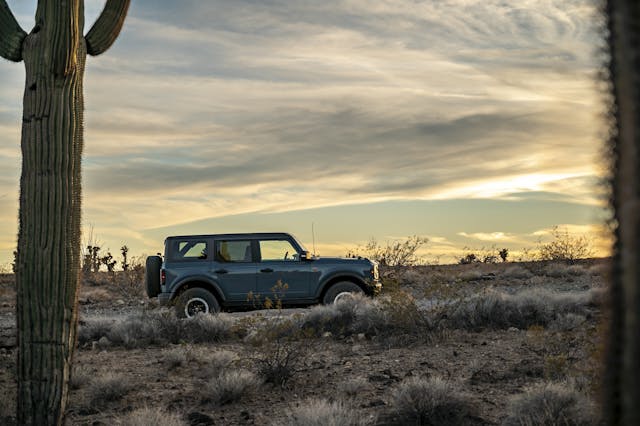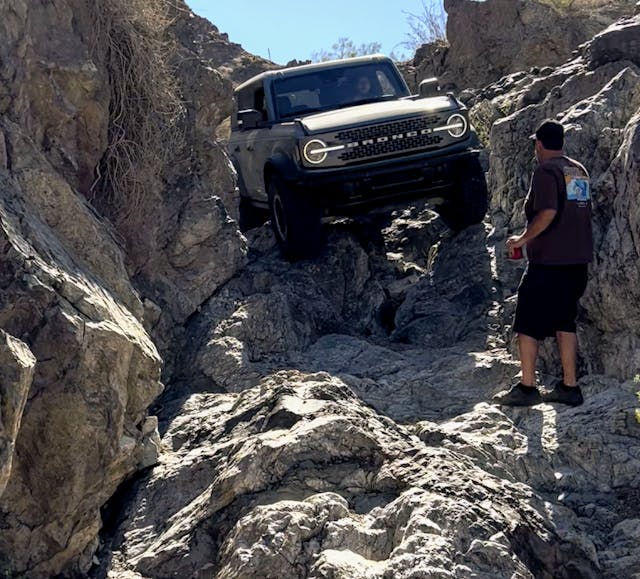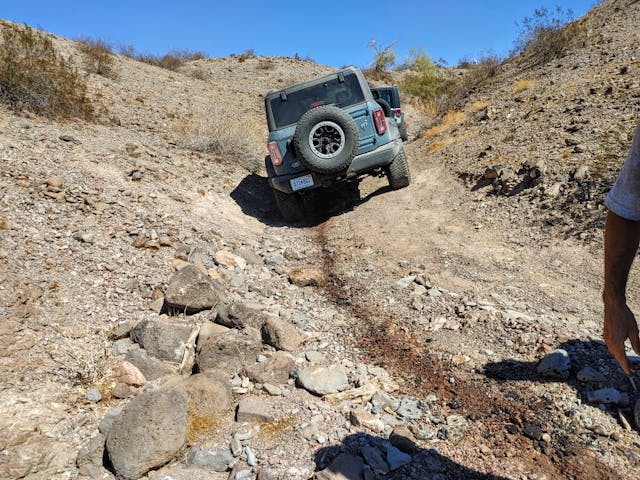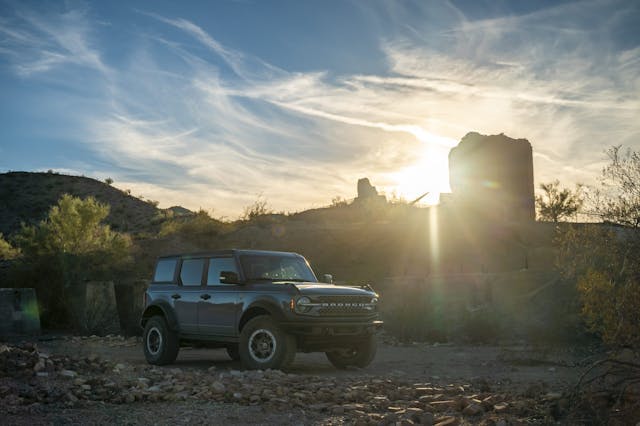Off-Road Review: 2021 Ford Bronco Badlands
It’s been a long time since Ford showrooms had a Bronco, but it’s been even longer since Ford envisioned the bucking-horse SUV as a Jeep competitor rather than a full-sized Blazer rival. How does this return to (kind of) compact form stack up against the class-standard Wrangler off-road?
As equipped, our test Bronco’s price tag came out to $58,905, in part due to the Badlands trim level that adds over $11,000 to the MSRP of the base model. In addition to the electronically disconnecting swaybar, the real bait in the package, Badlands Broncos receive position-sensitive Bilstein shocks, front and rear locking differentials, an electronic cutting brake, additional skid plates, functional rock rails, and a “modular” bumper with removable end caps. On top of that, the $2450 Sasquatch package was added, bringing a 4.7:1 axle ratio to spin the stocky 35-inch tire combo offered off the showroom floor with legitimate bead-lock wheels (you’ll have to install the tire in the bead-locks yourself), and a set of high-clearance fender flares to accommodate them without rub.
Separate from the exterior trim options, Ford offers four levels of interior comfort, ours adding $5085 for the Lux package which included the large 12-inch LCD screen in the center stack, the full complement of Ford’s driver assist features—adaptive cruise, lane-keeping, emergency braking and steering assists—along with dual-zone climate control, heated seats and steering wheel, a 360-degree camera view, and Danish-tuned stereo with Bang & Olufsen drivers stuffed in every corner of the interior. Throw in a $595 tow package, the $695 hardtop roof, and a couple other odds-and-ends for accessories like storage bags for the removable doors and the numerical keyless entry pad, and it’s certainly one of the most loaded configurations offered, and aimed squarely at the Wrangler Rubicon for capability and options.

The exterior design is a polarizing mix of thoughtful functionality that’s occasionally sacrificed for an element of retro vanity. Starting up front, the modular bumper is easily disassembled with a T-40 torx bit (strangely not included in the Bronco-branded tool kit) and reveals a meaningful amount of approach clearance for the front tires while also shrinking the width to keep it out of trouble in tight situations. The mast antenna is rubber at its base, so it easily tucks under branches without the risk of breaking off there, as traditional hard-mounted antennas are prone to suffer—yeah, you’re supposed to spin them off, but nobody ever does.
The camera system is comprehensive, but you’ll lose the 360-degree top-down view if the mirrors are folded, as they contain the left and right cameras and just bring a close-up of the door once tucked. The hood line is also quite tall on the Bronco, with its retro stylized ridges along the fenders further consuming your field of view—it’s a handsome machine that still feels like it’s fresh out of concept art, but it comes at a cost of having clear sight lines. This can create some unnerving dependency on the cameras, especially for drivers who are closer to the bottom of the five-foot range. The two wide-angle front views will be the most used to keep the nose out of trouble in tight situations. The Wrangler has a lower, narrower hood, making it more natural to maneuver close to obstacles with its better sight lines.
Here’s the biggest challenge the Bronco faces off-road: It’s wide. We’re not talking simply wider than just the Wrangler’s sheetmetal at its extremes, but even wider than a handful of mid-’90s full-size trucks. The truth is that much of America’s best trails are more limited by means of a vehicle’s physical size than its outright suspension stretch. Everytown USA’s local trail networks were most likely scouted by some plucky Jeeper, if not already chasing wagon trails, meaning that the nooks and crannies that make up common “Jeep squeeze” obstacles tend to flatter the inherently compact dimensions of a Wrangler (and its descendants). By rough measurements, the Bronco out-shoulders a JL Wrangler by approximately 10 inches at the nose (roughly 5 inches on either side) and it’s about 6 inches wider at the tail lamps (about 3 inches on either side).

Breaking out the tape measure later helped me to determine whether or not it was worth chucking the Bronco into Adventure Canyon, though it made two things more crucial. First, we’d need every bit of articulation offered out of the Ranger-based chassis in order to keep the body level and centered away from rock faces through obstacles. Second, keeping the Bronco on a tight line required it to drive naturally and predictably—not always easy in modern enthusiast vehicles that must balance driver inputs with increasingly complicated steering, braking, and throttle systems.
On paper, it practically matches the Wrangler on approach, break-over, and departure angles, and the differences are scant in reality. Despite its extra width both in sheetmetal and track width, the attention to tidy overhangs ahead of and behind the axle center lines helps keep the otherwise broad-shouldered Bronco from getting hung up on obstacles. Ford was even keen to tuck the exhaust tip into the chassis to prevent it from being crushed while coming off a tall shelf, as is notorious in Jeeps. However, the fuel tank, which sits under the rear-passenger seat, hangs well below the frame, unlike in the Wrangler, and does become a bit of a hang-up spot when tip-toeing through boulder fields and other uneven obstacles—if you have any intent to “wheel” one, consider at least ordering Black Diamond for the lowest-cost way to get the factory “heavy-duty bash plates,” modular bumper, and rock rails. The Sasquatch package alone doesn’t offer them and the extra protection and clearance will make a difference in many trails. With the modular bumper up front stripped down for the best tire clearance, it never made contact and while the rear tow hooks tagged a rock every so often, the rear bumper too had enough clearance to deal with steep drops. It’s worth noting, too, that the fender flares are fastened with simple twist latches and can be removed easily to shrink the Bronco down to its minimal girth.

The interior also carries over Ford’s thoughtful approach to truck interiors with a functional layout that still feels unique to the Bronco despite carrying some common Ford switchgear. The ergonomics are, by and large, fantastic, with a wide range of adjustments in the front seats and enough range in the tilting-and-telescoping wheel to accommodate different drivers. The dash’s shape also lends well to the rugged situations Ford expects you to be in. The upper edge where the various off-road features are located—the lockers, sway bar disconnect, cutting-brake, etc.— creates a bit of a hand-hold for the crook between your thumb and pointer finger, allowing yourself to brace and clamp the dash with a hand to operate lockers on the fly without having to glance down to reposition if your torso is getting tossed around off-road. There’s a bit of a shelf underneath the 12-inch center screen too, which also helps to stabilize your hand while trundling through maps or music. While not entirely useful at factory ride heights, the handles in the corners of the dash will certainly be loved by those who eventually lift the Bronco into absurdity. The center cubby below the infotainment and HVAC controls has well-implemented wireless charging, with plenty of space for large phones and enough wattage to charge through cases even while running things like Apple CarPlay and Android Auto. When the center screen is turned off manually, its backlight also shuts down, going a long way to reduce eye strain and help with night vision on dark roads.
A few complaints: The tachometer in the LCD gauge cluster might as well not even be there; it’s a subtle bar graph and a slightly unnatural two-digit format (1.9 = 1900 rpm) that makes quick glances at rpm a strain. There’s also times where the dash can become overwhelmed by various messages, alerts, and warnings that stack over each other with the vigor of AOL-era pop-ups. Many feel like the results of pedantic legal teams: reminders that the engine is running, tire pressure is low while aired down, various off-road features are active or may be changing state, each necessitating an acknowledgement to clear and return to the basic gauge displays. Oftentimes, too, they just become hazardous distractions. The most baffling, though, is the interference between the rear lift glass and tailgate. The gas strut that opens the tailgate has two positions, the first of which isn’t wide enough for the back glass weatherstripping to clear the tailgate, while the second position is finicky to quickly open the door to while the gas strut rubber bands and catches up.

For the most part, Ford nails the implementation of its off-road features in the Bronco. The lockers, sway bar, and cutting-brake are predictable and engage reliably, but the electronic transfer-case introduces its own unnecessary complications, such as requiring the SUV to be at a dead stop to shift between high and low range. Most 4x4s can make the change between low and high range at walking speeds, but the Bronco will force you to halt progress for ten seconds or more. And still, too, there are times where it can’t make the drop into 4-low without putting the vehicle back in gear to roll it and bring it back to a stop so the transfer case can attempt again to mesh—the exact drivetrain bind that rolling during the shift traditionally alleviated. This sounds trivial at a glance, but in a trail run, nobody wants to be that guy who holds up the line and has to fiddle around. It’s just not something the Wranglers suffer, thanks to their simpler, manual-shift transfer cases. Shifting the transfer case into neutral, for flat towing, is also more convoluted than it needs to be, with vague directions behind buried menus for what is a standard gear position in traditional transfer cases.
Oh, and there’s plenty of wind noise. Some calls over the Bronco’s hands-free system were difficult to maintain at freeway speeds thanks to the wind-rush over the upright windshield. Depending on the direction of the wind, a loud, high-pitch whistle developed around the passenger A-pillar. The pre-production units we tested in our first drive also had occasional wind leaks with the hard-top, suggesting this may just be a compromise with having frameless windows seal to multiple panels. It’s just a tough annoyance to swallow on a vehicle that costs nearly $60,000, especially given Ford’s promises of on-road refinement compared to the cross-town rival at Jeep.


There’s really nothing dramatic to report on pavement; it handles rough roads and long freeway drives well with more than adequate horsepower for passing. Fuel economy in mixed driving ranged from 15 to 17 mpg, which is respectable given the meatball tires under the fenders. While it’s my experience that only the low-trim Wranglers suffer excessive wandering or bump steer in the front axle (with the base shock package), every variant of the Bronco we’ve tested has maintained Ford’s promise of civilized street manners.
Western Arizona’s terrain through the Colorado River Valley is diverse, sampling soils from the Southwest’s most popular surfaces. There’s a mix of slick rock that’s familiar to any Moab regular, challenging a driver’s finesse on the bowling alley-smoothness that saps grip, interspersed craggy stone obstacles that feels peeled off any mountainside. Off the hard-packed-gravel access roads and washes, the desert sand itself lends to a unique dynamic beyond typical dunes, with a firm crust that gives way to its silty foundation once churned by spinning tires, giving some trails an all-or-nothing feel through real consequences for mistakes. Ford once owned a proving grounds a couple hours north, in Yucca, for the very same reasons that brings everyone else to the wild west: It’s epic wheeling in every direction that challenges a rig in multiple ways.
The trail chased a dried creek that had carved its way through the desert floor, descending into a large wash through a series of waterfall shelves, some a yard tall, before crawling back up through boulder fields on the other side, with a few miles of gravel roads on either end to access. Using a five-star rating system, opinions stretched between this sitting around 3.5 to 4 out of 5 on a difficulty scale—and naturally, Jeeps serve as another metric. For two doors, this trail would require 33-inch tires at a minimum while four-door Unlimiteds would really need a set of 35s to get through here comfortably; and lockers are a necessity. On paper again, the Bronco fit the bill with its meaty 315/70R17 Goodyear Wrangler Territory M/Ts and selectable lockers, but would the IFS become a limiting factor? Or could another Achilles heel be shaken out?

In technical rock-crawling sections, the Bronco excels with the sway bar disconnected, and it’s almost a crime that the feature isn’t available with the Sasquatch package without having to option up to the more expensive Badlands. Ford was keen to benchmark the Wrangler’s approximate travel specs, and where articulation did run out, the combination of front and rear lockers provided consistent traction even while teetering on two or three tires. Speaking of them, the Goodyears are a capable tire with a lot of flexibility in different surfaces. At 30 psi, they retain excellent sidewall stability for high-speed trails and gravel roads while soaking small bumps, and the footprint is wide enough to stay afloat in loose sand. Once aired down to at least 25 psi, they begin to stick like a cat on carpet to rocky terrain, and provided reliable traction to make corrections and adjustments while loaded up on an obstacle. It’s a combination that makes the Bronco’s width manageable as there’s enough capability to reach for difficult lines that ultimately keep the SUV level despite the trickier setup. Traction and travel are useless without the ability to finesse both at their absolute limits, and Ford’s calibration of the throttle and brakes when 4-low is engaged is excellently tied to the low tire speeds afforded by the 4.7:1 axle ratios. Ford offers a one-pedal drive mode that automatically applies the brakes as the throttle is released, while more advanced drivers will find no problems with left-foot braking (holding the throttle steady and only using the brake to manipulate speed).
In some situations, it still feels like the Wrangler has more practical articulation up front, but given how high the bar is already set for both SUVs, it’s just in rare moments of teetering that the Bronco’s suspension limits are found. On wide-open trails, like access roads and desert roads, the position-sensitive Bilsteins do an excellent job of soaking up large body motions and bumps, with a progressively tighter damping rate as the suspension compresses. It’s well-tuned to handle washboard roads, too, with the suspension able to quickly absorb the next high point without transmitting that impact into the chassis. In loose surfaces, the Bronco has the power and stability to build an entertaining amount of slip angle too, with an unobtrusive stability control and a predictable balance to how weight will transfer.

Throughout our run down Adventure Canyon, the Bronco managed to crawl through the trail’s notorious tail-light killers and chest-high drops, chasing a variety of Wrangler Rubicons with minor differences in the lines chosen. The additional width gave my spotter a few extra grey hairs, but with the right combination of lockers called upon, it was easy to position the Bronco where it needed to go—though even with the comprehensive camera system, visibility for the front-passenger corner was still a point of concern when a spotter wasn’t around. As we began chasing gravel roads out was when the Bronco’s only real weakness became apparent.
The 10R80 transmission used in the Bronco features, rather bafflingly, a plastic oil pan with no protection from impacts. While off-roading, it’s generally understood that everything underneath the body is subject to moshing with the terrain. With the Bronco’s “bash plates,” all major components except the transmission receive stout, steel skid plates—but like the thermal exhaust port of the Death Star, there was still a weak spot that could be hit under the correct circumstances …


This branch, hardly thicker than a broom stick, was kicked up by the front tire and was guided by Lotto-grade luck into the side of the transmission pan, breaking through the plastic wall and emptying several gallons of ATF. If we accept that debris is just a fact of life off-road, then mitigation here deserves attention. The transmission pan is exposed between the engine and transfer case skid plates. The choice to use a fragile plastic oil pan is less than ideal. Since we were rolling with a group, this wasn’t too much of an ordeal to rope tow out to a trailhead for a flat-bed to pick it up, but had we been further out from civilization on an overland route, it could’ve introduced a real problem in safely getting home. Thankfully, most of the mechanical components on the Bronco are shared with other Ford vehicles, and a new transmission pan was sourced by a dealership in short order, side-stepping some of the same supply chains that have caused delays in the Bronco’s mainline production.
Out of the box, the Bronco stretches and flexes just enough to keep up with its entrenched competition from Jeep in most trail networks. While its larger dimensions will eventually put the Bronco into a situation, your results will vary depending on where you intend to wheel. The real departure in capability comes when Wranglers with bolt-on coil-over kits enter the mix: With a small budget they become street-legal rock crawlers. The big test in the long term will be to see what the Raptor variant brings to the table, or what capability is brought out by the aftermarket industry. What capability the Bronco trades off with IFS pays dividends on the road, with confident handling and low strain over long highway treks. Ford couldn’t simply build a tit-for-tat clone of the Wrangler, and the Bronco feels like its own answer to the do-all off-roader. Real talk: This is the SUV the Toyota 4Runner TRD Pro wishes it could be.

2021 Ford Bronco Badlands
Base price/As-tested: $46,335/$58,905
Highs: The Bronco largely lives up to the hype, and delivers on an authentic and capable off-roading experience. With the Badlands’ electronically disconnecting sway bar, the Bronco displays a duality in its suspension that can both handle high-speed antics that live up to its Baja GOAT mode and still retain enough compliance for crawling through tricky obstacles. Even when you’re not storming across the dirt, the Bronco lends itself to a comfortable street persona, with excellent stability at highway speeds and over broken roads.
Lows: The frameless windows may be the source of many NVH issues as the Bronco ages, with wind leaks being a common trait across the units we’ve tested. Visibility over the hood is lost to retro styling, creating more dependence on a camera system that’s mounted fairly low in the dash. While it’s easy to configure the stability nannies for hands-off consistency off-road, the message center in the gauge cluster can still be overwhelmed by stacks of nuisance warning messages. And despite an otherwise comprehensive body and chassis protection package in the form of the optional “bash plates,” leaving the transmission pan so vulnerable is a concern in an enthusiast product like this.
Summary: If you’re looking to maximize on-road driving while keeping a super-capable off-roader in the stable, the Bronco is a clear choice. Out of the box, it serves the capability the vast majority of people would expect, and the jump to the Wrangler’s solid-front-axle may just make better sense for those intending to dive deeper into the off-road hobby. With the 35s and both axles locked, the Bronco will manage its way through many popular trails, just pay mind to order the rock rails and bash plates if you expect to crawl through tougher obstacles.


